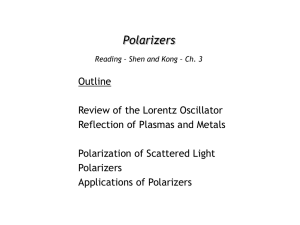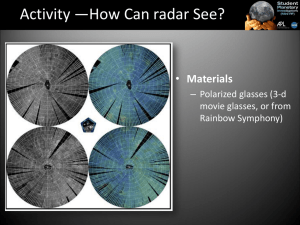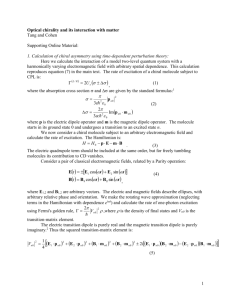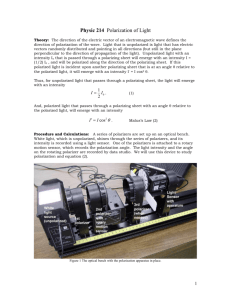(polarization). - Physics at Oregon State University
advertisement
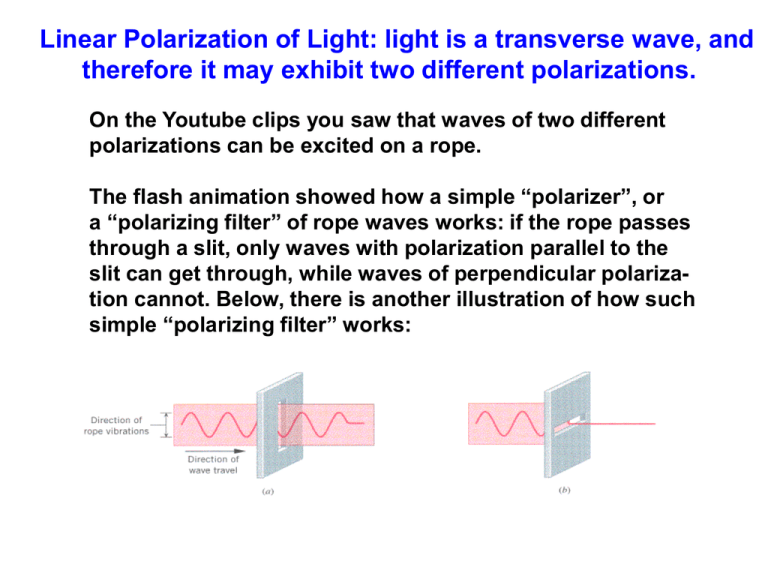
Linear Polarization of Light: light is a transverse wave, and therefore it may exhibit two different polarizations. On the Youtube clips you saw that waves of two different polarizations can be excited on a rope. The flash animation showed how a simple “polarizer”, or a “polarizing filter” of rope waves works: if the rope passes through a slit, only waves with polarization parallel to the slit can get through, while waves of perpendicular polarization cannot. Below, there is another illustration of how such simple “polarizing filter” works: Light is an electromagnetic wave. There is no “displacement” that oscillates and travels forward as in the case of all mechanical waves. The oscillating things here are the electric and the magnetic field. They oscillate in planes that are perpendicular to each other. So, what is the polarization of the EM wave shown below? We have to choose one of the fields as the one that defines the polarization direction. By convention, this is the electric field vector. Why did we start with waves on ropes, and not right away with light? Well, because waves on ropes are certainly “intuitive clear”, and there is much analogy between the polarization of waves on ropes, and the polarization of light. Light emitted by most natural and man-made sources is a “mixture” of waves of all possible polarizations. And in order to obtain polarized light, we can use polarizing filters, in analogy to the slit used for polarizing the waves on a rope. Also, for obtaining polarized light we can use some phenonomena, such as polarization by reflection, or an effect known as “birefringence”. However, devices based on these effects are called “polarizers” rather than “polarizing filters”. WARNING! A COMMON MISCONCEPTION! Because we say that “there is much analogy between the polarization ff light waves and the polarization of waves on ropes”, students may get the impression that slits, or arrays of many parallel slits can also be used as polarizers of light. Such an impression may be even strengthened by the fact that an often used graphic symbol of a light polarizer has the form of a circle or a square filled with many parallel lines (see the example below). Remenber, this is a totally wrong thinking! Slits, even very narrow, DO NOT ACT AS LIGHT POLARIZERS! The lines on the graphs do not symbolize an array of slits – they only indicate the polarization of the light waves that get through the polarizer. If not slits, what’s used for polarizing light? We’ll discuss three methods: The most popular polarizer type is polarizing foil. It was pioneered by the well-known Polaroid company, and therefore its often called “polaroid”. How it works? Here is the explanation (perhaps slightly oversimplified): The incident unpolarized beam is first “organized” by the molecular structure of the foil into two waves of perpendicular polarization – and then the same molecules absorb (almost completely) one of them, while the other gets through. Exercise: hold one polaroid in front of your eye. Look at a light source. Put another piece of foil in front of the first one, and turn it at various angles. Another nice picture explaining how polarizing foil works: BTW, the direction along which light is polarized by a given device is called the “polarizing axis”, or “polarization axis” of the device. This is what you should see… …and here is the explanation, which is quite straightforward, right? A considerable advantage of foil polarizers is that they are inexpensive – so they are widely used! Two. Polarization by reflection: the reflected and refracted waves are always partially polarized. But in the special case when the angle between the reflected and the refracted beam is exactly 90º (see below), the reflected wave is totally polarized, parallel to the reflecting surface. Let’s find the condition for the reflected and refracted ray being perpendicular: p 90 b 180 So : b 90 p b 90 p Then : sin b sin 90 p But : sin( 90 ) cos ( trigonomet ric identity) So : sin b cos p Now, recall the Snell' s Law : And insert wha sin p sin b sin p sin b t we got for sin b : sin p cos p tan p n n This is the condition for the reflected wave to be 100% polarized. The incident angle satisfying this condition is called the Brewster Angle. Because of the “inconvenient geometry” – the polarized wave does not travel along the same direction as the incident wave -polarization by reflection is not very often used in practical devices, even though it is perhaps the least expensive method! However, in its own right polarization by reflection is an important phenomenon. For instance, sometimes it helps to eliminate unwanted or troublesome light reflections. We will return to that shortly. Three: polarization by the effect of birefringence. Some crystals have the peculiar property, called birefringence: A light ray incident on a birefringent material is split into two beams, called the ordinary (o ray) and extraordinary ray (e ray), that have mutually perpendicular polarizations. Calcite (a crystalline form of CaCO3) is transparent, completely colorless, and exhibits unusually strong birefringence properties. (calcite crystals will be now passed around). The so-called “Nicol prism”. It is made of two pieces of calcite with a gap between, filled with “Canada Balsam” (a transparent glue). Due to the different refractive indices of the ordinary and the extraordinary waves, the ordinary undergoes a total internal reflection and is removed from the prism, while the extraordinary gets through. The Nicol Prism is an extremely efficient polarizer, but very expensive. Therefore, it is used only in apparatus in which high precision is crucial. OK, over with the methods of polarizing light! Now, a mini-problem, and then a practical exercise: Suppose that you have two polarizers, but the direction of the Polarizing axis is not marked on any of them. HOW TO FIND THE POLARIZING AXIS DIRECTION? It is not difficult to find situations in which the polarizing axes are parallel, or are crossed… ...but it still does not tell us what their exact orientation is: ? ? ? What happens if the polarizing axes are neither parallel, nor crossed, but they make an arbitrary angle θ ? What is the intensity of the wave transmitted by the second? (in such configuration, we call the first “polarizer”, but the second is now the “analyzer”). Recipe: the amplitude of a wave can be thought of as a vector. Let’s denote the amplitude after the polarizer as E . Now, " decompose" the E vector into a component parallel to the analyser' s axis : E par E cos and a component E perp perpendicu E sin This one can go! (green light) lar to it : This one is stopped! (red light) What we register by eyes, or using photodetectors, is the light intensity, which is proportional to the square of the amplitude. Intensity before the analyzer Intensity after the So, the intensity T I I : transmissi E cos 2 analyzer : I E 2 I E cos on coefficien 2 E 2 cos 2 t is : 2 E cos 2 2 Optically active media: Some materials and compounds have the ability of “twisting” the polarization direction of light passing by them. We call them “optically active”: In some materials (most notably, in plastics) the optical activity is caused by “residual internal strains” existing in the material due to the fast cooling from the molten state in the production process. In addition, the rate of polarization axis “twist” caused by such strains may significantly vary for different light wavelengths, i.e., light colors. As the result, when such plastic is put between two crossed polarizers and placed in a beam of white light, some colors may get through, and some may be extingushed, producing spectacular patterns. The photo shows such a pattern obtained by putting crumpled cellophane between crossed polaroids. (pieces of plastic + polaroids will be passed around). Saccharimetry – one of the many practical applications of measurements of the polarization axis rotation. One of the best known examples of optically active media is water solution of ordinary sugar (demo). By measuring of how much the polarization direction is rotated by a sample of sugar-containing fluid, one can determine the sugar concentration in it. This method is widely used in medical analysis for checking the sugar content in blood, urine and other body fluids.

